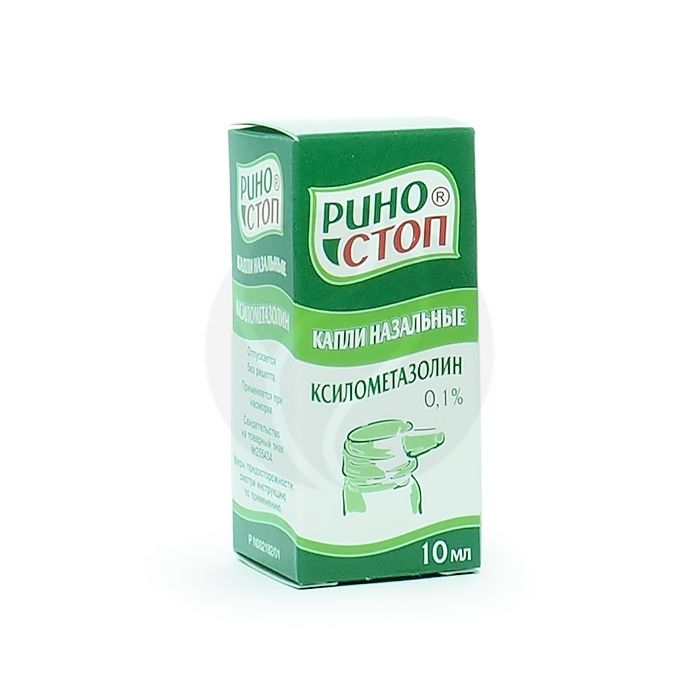Rinostop drops 0.1%, 10ml
Expiration Date: 05/2027
Russian Pharmacy name:
Риностоп капли 0.1%, 10мл
To reduce swelling of the nasopharyngeal mucosa and discharge in acute allergic rhinitis,
ARI with symptoms of rhinitis, sinusitis, hay fever, otitis media;
preparation of the patient for diagnostic procedures in the nasal passages.
Intranasally, in each nasal passage, adults and children over 6 years old - 1-2 drops (0.1% solution) 2-3 times a day, children from 2 to 6 years old - 1-2 drops (0.05% solution) 1-2 times a day.
Apply no more than 3 times a day for 3-5 days (for longer use, a break of 3-5 days is required).
Nasal drops
1 ml
xylometazoline hydrochloride
Hypersensitivity to xylometazoline;
atrophic rhinitis, thyrotoxicosis;
inflammatory diseases of the skin or mucous membrane of the vestibule of the nose;
condition after transsphenoidal hypophysectomy; patients with severe cardiovascular diseases (for example, ischemic heart disease, angina pectoris, tachycardia, arterial hypertension, severe atherosclerosis);
patients with a history of surgical interventions on the meninges;
patients receiving MAO or other drugs that can cause an increase in blood pressure;
patients with increased intraocular pressure, especially with angle-closure glaucoma;
during therapy with tricyclic and tetracyclic antidepressants, other local vasoconstrictor agents (decongestants);
pregnancy;
children's age - depending on the dosage form.
With care: patients with hypersensitivity to adrenergic agonists, accompanied by symptoms of insomnia, dizziness, arrhythmias, tremors, increased blood pressure; patients with pheochromocytoma, porphyria; patients with endocrine diseases (eg, hyperthyroidism, diabetes mellitus); patients with prostatic hyperplasia; during lactation (breastfeeding).
pharmachologic effect
A vasoconstrictor for topical use in ENT practice. Alpha adrenergic agonist. When applied to mucous membranes, it causes narrowing of the blood vessels of the nasal mucosa, thus eliminating edema and hyperemia of the nasal mucosa, restores the patency of the nasal passages. With rhinitis, it makes nasal breathing easier.
Pharmacokinetics
When applied topically, it is practically not absorbed, plasma concentrations are so small that they cannot be determined by modern analytical methods.
Side effect
From the immune system: infrequently - hypersensitivity reactions (angioedema, skin rash, itching). From the digestive system: rarely - nausea, vomiting. From the side of the nervous system: rarely - headache; very rarely - insomnia, anxiety, fatigue, hallucinations and convulsions (mainly in children). From the side of the organ of vision: very rarely - impaired clarity of vision. From the side of the cardiovascular system: rarely - a feeling of palpitations, increased blood pressure, tachycardia; very rarely - arrhythmia. Local reactions: often - irritation and / or dryness of the nasopharyngeal mucosa, burning and paresthesia of the nasal mucosa, sneezing, hypersecretion of the nasal mucosa; infrequently - swelling of the nasal mucosa, nosebleeds, withdrawal syndrome.Increased swelling of the nasal mucosa (reactive hyperemia) is possible.
Application during pregnancy and lactation
Contraindicated in pregnancy. During lactation, use is possible only as directed by a doctor, after a careful assessment of the ratio of the expected benefits to the mother of the potential risk to the child. Do not exceed the recommended doses.
Application in children
It is possible to use in children according to indications, in doses and dosage forms recommended according to age. It is necessary to strictly follow the instructions in the instructions for xylometazoline preparations on contraindications for the use of specific dosage forms of xylometazoline in children of different ages. Do not exceed recommended doses in children.
Use in elderly patients
The recommended dose should not be exceeded in elderly patients.
special instructions
Long-term use (more than 7 days) and overdose of sympathomimetics that have a decongestant effect can lead to reactive hyperemia of the nasal mucosa. As a result, there is difficulty in nasal breathing, which leads to the fact that the patient begins to use xiometazoline repeatedly or even constantly. This can lead to chronic swelling (medication rhinitis), and eventually even to atrophy of the nasal mucosa (ozenes). In milder cases, to improve the patient's condition, you can first stop the introduction of sympathomimetic in one nostril, and after reducing complaints, continue to inject it into the other nostril in order to at least partially provide nasal breathing. Recommended doses should not be exceeded, especially in children and elderly patients.Influence on the ability to drive vehicles and control mechanisms With prolonged treatment or with the use of xylometazoline in higher doses, the possibility of its systemic action cannot be excluded. In the case of the development of systemic side effects, it is necessary to refrain from driving vehicles and engaging in other potentially hazardous activities that require an increased concentration of attention and speed of psychomotor reactions.
Drug interactions
It is possible to increase the systemic action of xylometazoline with the simultaneous use of MAO inhibitors and tricyclic antidepressants. The simultaneous use of xylometazoline with tetracyclic antidepressants, other local vasoconstrictors (decongestants), and other drugs that increase blood pressure is incompatible.

